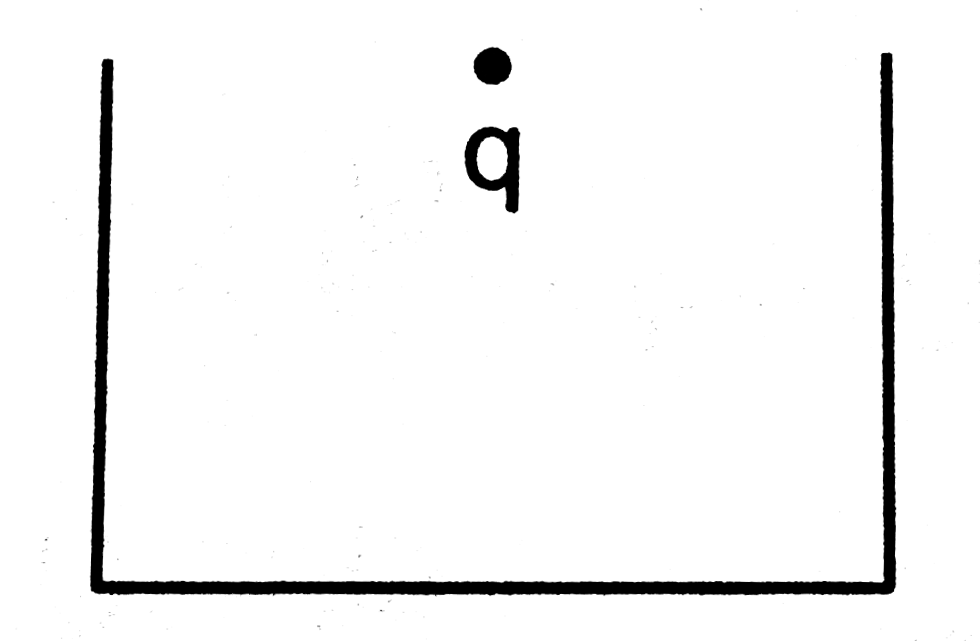If charge q1 and q2 lies inside and outside respectively of a closed surface S. Let E be the electric field at any point on S and ϕ be the electric flux over S. Select the incorrect option.
If q1 = 0 and q2≠0,then E=0 but ϕ≠0
If q1 changes,both E and ϕwill change
If q2 changes, E will changes but ϕ will not change
If q1≠0 and q2≠0,then ϕ≠0
The correct Answer is:A
To solve the problem, we need to analyze the relationship between electric field (E) and electric flux (ϕ) in the context of charges inside and outside a closed surface (S).
1. Understanding the Setup:
- We have two charges: q1 (inside the closed surface S) and q2 (outside the closed surface S).
- The electric field E at any point on the surface S is influenced by both charges, but the electric flux ϕ through the surface S depends only on the charge enclosed by the surface.
2. Applying Gauss's Law:
- According to Gauss's Law, the electric flux ϕ through a closed surface is given by:
ϕ=qencϵ0
- Here, qenc is the charge enclosed by the surface, which in this case is q1. Thus:
ϕ=q1ϵ0
3. Electric Field Contribution:
- The electric field E at any point on the surface S is due to both charges q1 and q2. Therefore, if either charge changes, it can affect E:
- If q1 changes, both E and ϕ will change.
- If q2 changes, only E will change, while ϕ remains constant since q1 is still the only charge enclosed.
4. Analyzing the Options:
- Option A: If q1=0 and q2≠0, then E is not necessarily zero (due to q2), but ϕ=0. This option is incorrect because it states E=0 which is false.
- Option B: If q1 changes, both E and ϕ will change. This is correct.
- Option C: If q2 changes, E will change, but ϕ will not change. This is correct.
- Option D: If q1≠0 and q2≠0, then ϕ≠0. This is correct.
5. Conclusion:
- The incorrect option is Option A.
- We have two charges: q1 (inside the closed surface S) and q2 (outside the closed surface S).
- The electric field E at any point on the surface S is influenced by both charges, but the electric flux ϕ through the surface S depends only on the charge enclosed by the surface.
- According to Gauss's Law, the electric flux ϕ through a closed surface is given by:
ϕ=qencϵ0
- Here, qenc is the charge enclosed by the surface, which in this case is q1. Thus:
ϕ=q1ϵ0
- The electric field E at any point on the surface S is due to both charges q1 and q2. Therefore, if either charge changes, it can affect E:
- If q1 changes, both E and ϕ will change.
- If q2 changes, only E will change, while ϕ remains constant since q1 is still the only charge enclosed.
- Option A: If q1=0 and q2≠0, then E is not necessarily zero (due to q2), but ϕ=0. This option is incorrect because it states E=0 which is false.
- Option B: If q1 changes, both E and ϕ will change. This is correct.
- Option C: If q2 changes, E will change, but ϕ will not change. This is correct.
- Option D: If q1≠0 and q2≠0, then ϕ≠0. This is correct.
- The incorrect option is Option A.
Similar Questions
Charges Q1andQ2 lie inside and outside, respectively, of a closed surface S. Let E be the field at any point on S and ϕ be the flux of E over S.
View SolutionCharges Q1andQ2 lie inside and outside, respectively, of a closed surface S. Let E be the field at any point on S and ϕ be the flux of E over S.
View SolutionThe point charges Q and −2Q are placed at some distance apart. If the electirc field at the location of Q is E, the electric field at the location of −2Q will be
View SolutionS1 and S2 are two hollow concentric spheres enclosing charges Q and 2Q, respectively, as shown in figure.
i. What is the ratio of the electric flux through S1 and S2?
ii. How will the electric flux through sphere S1 change if a medium of dielectric constant 5 is introduced in the space inside S1 in place of air.
 .
.
View SolutionIf the flux of the electric field through a closed surface is zero ,
(i) the electric field must be zero everywhere on the surface
(ii) the electric field may be zero everywhere on the surface
(iii) the charge inside the surface must be zero
(iv) the charge in the vicinity of the surface must be zero
View SolutionA charge q is placed at the centre of the open end of a cylindrical vessel . The flux of the electric field through the surface of the vessel is

View SolutionA charge Q is placed at the centre of a cube. Find the flux of the electric field through the six surfaced of the cube.
View SolutionIf an isolated infinite plate contains a charge Q1 on one of its surfaces and a charge Q2 on its other surface, then prove that electric field intensity at a point in front of the plate will be Q/2Aε0, where Q=Q1+Q2
View Solutionn charged drops, each of radius r and charge q, coalesce to from a big drop of radius R and charge Q. If V is the electric potential and E is the electric field at the surface of a drop, then.
View SolutionAn infinite line charge is at the axis of a cylinder of length 1 m and radius 7 cm. If electric field at any point on the curved surface of cylinder is 250 NC−1, then net electric flux through the cylinder is
View Solution
